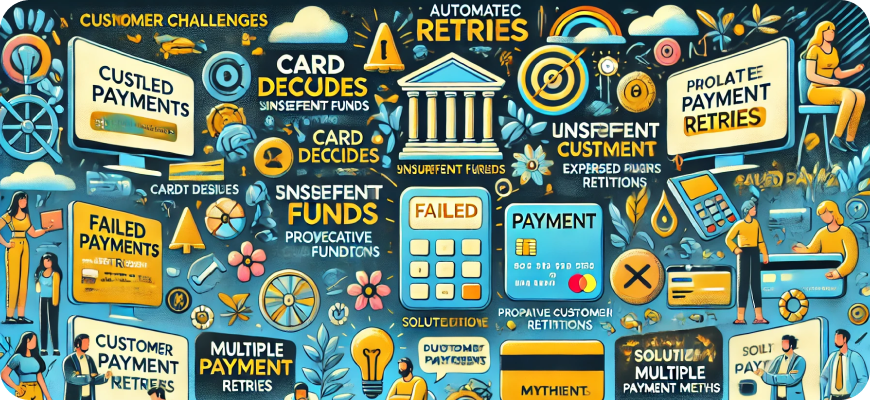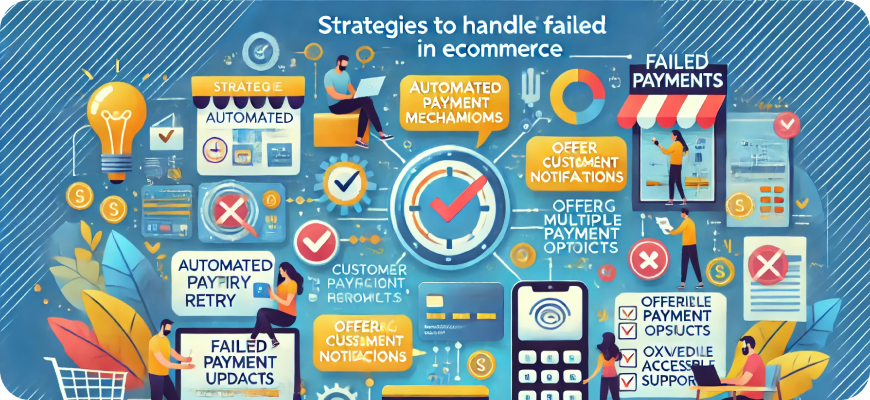What to Do with Failed Payments in Your Ecommerce?
Failed payments are a common issue faced by ecommerce businesses and can have a significant impact on revenue and customer relationships. Payment failures occur for various reasons, such as expired credit cards, insufficient funds, or network issues. Whatever the cause, addressing failed payments effectively is crucial for maintaining a healthy cash flow, minimizing customer churn, and delivering a positive customer experience. In this article, we’ll explore strategies and best practices to handle failed payments in your ecommerce business.

Understanding Common Reasons for Payment Failures
To effectively address failed payments, it’s important to understand why they happen in the first place. Common reasons include:
- Expired or Invalid Credit Cards: Credit cards have expiration dates, and customers may forget to update their payment information.
- Insufficient Funds: Customers may not have enough money in their accounts at the time of the transaction.
- Network Errors: Payment gateways or banks may experience temporary technical issues.
- Bank Restrictions: Some banks may block certain transactions for security reasons or if they are deemed unusual.
- Incorrect Payment Details: Typos or incorrect entry of payment details can cause payment failures.
- Card Limits: Customers may have reached their spending limit on their card.
Impact of Failed Payments on Your Ecommerce Business
Failed payments can have several negative consequences, including:
- Revenue Loss: Every failed payment represents lost revenue. If not properly managed, this can significantly impact your business’s bottom line.
- Customer Churn: Customers who experience repeated payment failures may become frustrated and leave for competitors.
- Operational Costs: Dealing with failed payments, such as follow-ups and manual interventions, can increase operational costs.
- Negative Customer Experience: Payment issues can cause friction and negatively affect the customer experience, damaging brand loyalty.
Strategies to Handle Failed Payments

1. Implement Automated Retry Mechanisms
One of the most effective ways to manage failed payments is to implement automated retry mechanisms. Payment failures often happen due to temporary issues, such as insufficient funds or network errors, that can be resolved by retrying the transaction later.
- Smart retry logic: Use intelligent retry strategies that attempt the payment again at optimal intervals. For example, you can try again after 24 hours, 48 hours, and then one week.
- Customize retry frequency: Allow customers to set their own retry preferences or notify them about upcoming retries.
Automated retries minimize manual intervention and can recover a significant portion of failed payments.
2. Notify Customers of Payment Failures
When a payment fails, it’s essential to inform the customer promptly and clearly. Many customers may not be aware of the failure until they are notified.
- Email notifications: Send an automated email to notify customers of the payment failure. Clearly explain why the payment failed (if possible) and what steps they can take to resolve it.
- SMS alerts: For time-sensitive payments, consider sending an SMS notification in addition to email.
- In-app notifications: If your business has a mobile app, you can use push notifications to inform customers about failed payments.
Make your notifications customer-friendly, empathetic, and easy to understand. Include a direct link to update their payment information or retry the transaction.
3. Offer Easy Options for Payment Updates
Simplifying the process of updating payment information can reduce friction for customers and increase the likelihood of successful payments.
- Self-service portals: Provide a user-friendly portal where customers can update their payment details quickly and easily.
- One-click updates: If possible, offer one-click options to update payment information using a secure link.
- Multiple payment methods: Allow customers to switch to a different payment method if their preferred option fails (e.g., switching from a credit card to a digital wallet).
By making it easy for customers to update their payment details, you reduce barriers to completing the transaction.
4. Use Pre-Dunning Notifications
Pre-dunning refers to proactively notifying customers about potential payment issues before they occur. This strategy is particularly effective for subscription-based businesses.
- Card expiry reminders: Send reminders to customers whose credit cards are about to expire, asking them to update their payment information.
- Low-balance warnings: For customers who use bank accounts or debit cards, consider sending low-balance warnings if you have relevant data.
Pre-dunning notifications help prevent failed payments before they happen, improving overall payment success rates.
5. Provide Multiple Payment Options
Giving customers more choices for payment methods can reduce the likelihood of payment failures.
- Credit and debit cards: Support all major card networks to accommodate customer preferences.
- Digital wallets: Offer options like PayPal, Apple Pay, Google Pay, and other digital wallets.
- Buy Now, Pay Later (BNPL): Consider partnering with BNPL providers to offer flexible payment options.
- Bank transfers: Enable direct bank transfers or Automated Clearing House (ACH) payments.
The more payment options you provide, the easier it is for customers to find a method that works for them, even if one fails.
6. Leverage Machine Learning to Predict and Prevent Failures
Machine learning and artificial intelligence (AI) can help you identify patterns and predict potential payment failures.
- Behavioral analysis: Analyze customer behavior and transaction history to predict when a payment is likely to fail. Use this data to take proactive measures, such as sending reminders or adjusting retry strategies.
- Risk assessment: Identify high-risk transactions and implement additional security checks or fraud prevention measures.
By using data-driven insights, you can reduce payment failures and improve the customer experience.
7. Provide Transparent and Helpful Customer Support
When payment failures occur, some customers may need assistance to resolve the issue. Providing responsive and transparent customer support can make a big difference.
- Live chat and phone support: Offer live chat or phone support for customers experiencing payment issues. Ensure that your support team is knowledgeable and empathetic.
- FAQs and help articles: Create a comprehensive FAQ section or help center with articles that address common payment issues and their solutions.
- Multilingual support: If you operate globally, provide support in multiple languages to accommodate your diverse customer base.
Effective customer support can turn a frustrating experience into a positive one, improving customer satisfaction and retention.
8. Enable Secure Payment Tokenization
Payment tokenization is a security measure that replaces sensitive payment data with a unique token that can be used for future transactions. Tokenization reduces the risk of data breaches and simplifies the payment process.
- Recurring payments: For subscription businesses, tokenization ensures that customer payment data is securely stored and used for recurring payments without re-entering sensitive information.
- Faster updates: If a customer’s card is reissued, tokenized payment methods may automatically update the new card details without manual intervention.
Tokenization improves payment security and reliability, reducing the likelihood of failed transactions due to card updates.
9. Offer Flexible Payment Terms and Plans
Rigid payment terms can lead to failed payments, especially if customers are facing financial difficulties. Offering flexibility can improve payment success rates.
- Payment plan options: Allow customers to break large payments into smaller installments.
- Grace periods: Offer a grace period for customers to resolve payment issues before canceling their subscription or order.
- Pausing subscriptions: For subscription services, provide an option to pause the subscription temporarily rather than cancel it.
Flexible payment terms demonstrate empathy and can strengthen customer loyalty.
10. Optimize Your Payment Gateway Configuration
The performance of your payment gateway can significantly impact payment success rates. Optimizing its configuration can help reduce failures.
- Retry settings: Configure your payment gateway to automatically retry failed payments at optimal intervals.
- Multiple gateways: Consider using multiple payment gateways to provide redundancy and ensure that transactions are routed through the most reliable option.
- Gateway performance monitoring: Regularly monitor the performance of your payment gateway, including downtime, transaction success rates, and error codes.
By optimizing your payment gateway, you can improve payment reliability and reduce failures.
11. Communicate Proactively and Empathetically
How you communicate with customers about payment failures matters. Proactive and empathetic communication can prevent negative experiences.
- Use a positive tone: Frame notifications positively and offer reassurance. For example, instead of saying “Your payment failed,” try “We couldn’t process your payment. Here’s how we can help.”
- Offer assistance: Provide clear instructions on how to resolve the issue and offer to assist if needed.
- Follow-up reminders: If the initial notification goes unanswered, send follow-up reminders to encourage customers to resolve the issue.
Empathetic communication builds trust and reduces the likelihood of customer churn.
12. Address Fraud Concerns
Payment failures can sometimes be caused by fraud prevention measures, such as declined transactions due to suspicious activity.
- Fraud detection systems: Use advanced fraud detection systems to identify and mitigate fraudulent transactions while minimizing false positives.
- Communication with customers: If a transaction is flagged as suspicious, notify the customer and provide a way to verify their identity or payment method.
Balancing fraud prevention with customer convenience is crucial for minimizing failed payments.
Measuring and Analyzing Payment Success Metrics
To continuously improve your approach to handling failed payments, it’s important to track and analyze relevant metrics.
- Churn rate: Monitor your customer churn rate to understand how failed payments impact retention.
- Recovery rate: Measure the percentage of failed payments that are successfully recovered through retries or customer intervention.
- Failure reasons: Categorize failed payments by reason (e.g., insufficient funds, card expiration) to identify patterns and optimize your strategies.
- Customer feedback: Collect feedback from customers who experience payment failures to identify pain points and improve the process.
Data-driven analysis allows you to refine your strategies, reduce payment failures, and enhance the overall customer experience.

Conclusion
Failed payments are an inevitable part of running an ecommerce business, but they don’t have to be a major obstacle. By implementing proactive measures such as automated retries, clear customer communication, flexible payment options, and optimized gateway configurations, you can minimize payment failures and maintain a positive customer experience. Addressing failed payments effectively not only protects your revenue but also strengthens customer loyalty, paving the way for long-term success in the competitive ecommerce landscape.






